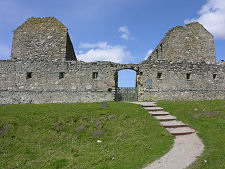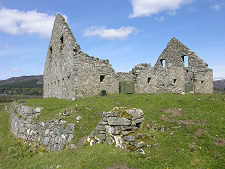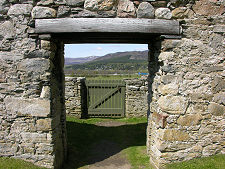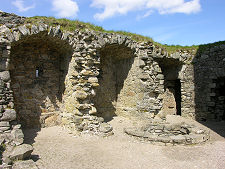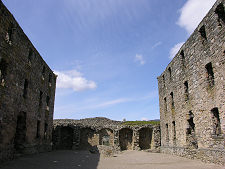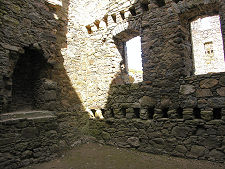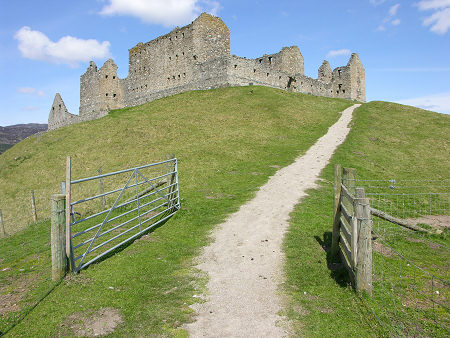 Ruthven Barracks from the Approach Path |
The impressive and nicely proportioned mound on which Ruthven Barracks stands is said to be a natural leftover of the retreat of the glaciers at the end of the last ice age. Its regularity suggests that man has taken a hand as well. The mound overlooks the site of an ancient ford and ferry between it and today's Kingussie. This was one of the few crossing places of the middle reaches of the River Spey before it was bridged near Newtonmore in 1808, and it lies at an important junction of the routes through the Cairngorms.
The first recorded castle to be built here appeared in 1229. By 1371 it formed the centre of activity of Alexander Stewart, 1st Earl of Buchan, and younger son of Robert II. More popularly known as the Wolf of Badenoch, Stewart is mainly remembered for falling out with the Bishop of Elgin and being excommunicated by him for marital infidelity. In retaliation he destroyed Elgin Cathedral, and much of Elgin, in 1390.
This first castle was destroyed in 1451, then rebuilt by 1459 as a much grander fortification. It was fought over during the Civil Wars, then badly damaged by Viscount Dundee, Bonnie Dundee and the Jacobites during the first uprising in 1689.
After the 1715 Jacobite uprising, the Government decided to tighten its grip on the Highlands by building four fortified barracks in strategic locations. Ruthven Barracks was one of them (another was Bernera Barracks in Glenelg), and all remains of the earlier castle were removed to make way for the structure you see today. The barracks took much longer to build than planned, and was finally completed in 1721 (see our Historical Timeline).
The barracks were designed to house 120 troops, split between the two barrack blocks. Officers lived separately. The stables, standing slightly to the west of the rest of the barracks, were built in 1734 to house 28 horses for dragoons. By this time its strategic importance had been enhanced by the building of General Wade's military roads from Perth, Fort Augustus and Inverness that came together here.
In August 1745 some 200 Jacobites tried to capture Ruthven Barracks. A force of just 12 redcoats, commanded by a Sergeant Molloy, fought them off with the loss of just one man. By February 1746 Sergeant Molloy had been promoted to Lieutenant, and was still in command when a larger force of Jacobites arrived, this time equipped with artillery. The garrison surrendered.
History had one more, final, role in store for Ruthven Barracks. On the day after the Battle of Culloden as many as 3,000 Jacobites assembled here under Lord George Murray with the intention of fighting on. Awaiting them was a message from Bonnie Prince Charlie saying that each man should save himself the best he could. The Jacobites set fire to the barracks, and dispersed to try to evade a Government now set on finally suppressing the Jacobites, and the Highlands, once and for all.
What visitors to Ruthven Barracks see today is pretty much what was left by the departing Jacobites on 17 April 1746. Most of the exterior walls remain, but little of the interior structure, and no flooring or roofing. But come here on a quiet day and you can have Ruthven Barracks entirely to yourself. The distant traffic on the A9 barely intrudes, and it takes very little effort to transport yourself back 250 years to the days when history was being made here.
And, if it's really quiet, and getting dark, watch out for ghostly chess-players. It is said that one evening in July 1394 a visitor dressed all in black arrived at Ruthven Castle and challenged Alexander Stewart, the Wolf of Badenoch to a game of chess. By morning, no-one was left alive in the castle: for such are the perils of playing chess with the Devil.
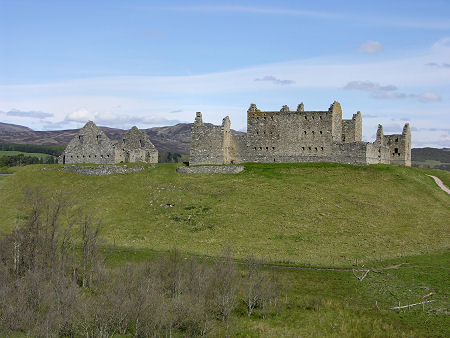 Ruthven Barracks from the South |
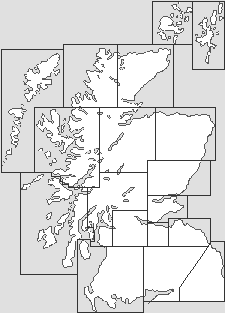
|
|
|
Visitor InformationView Location on MapGrid Ref: NN 764 997 www.historicenvironment.scot HES: Barracks Web Page What3Words Location: ///deal.supported.stub |
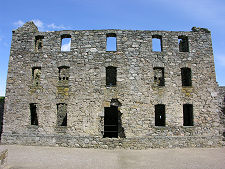 The Northern Barrack Block |
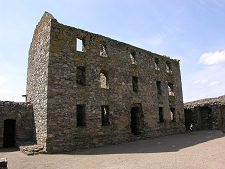 The Southern Barrack Block |
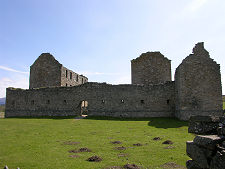 The Barracks from the Stables |
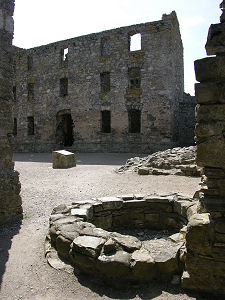 The Well |
